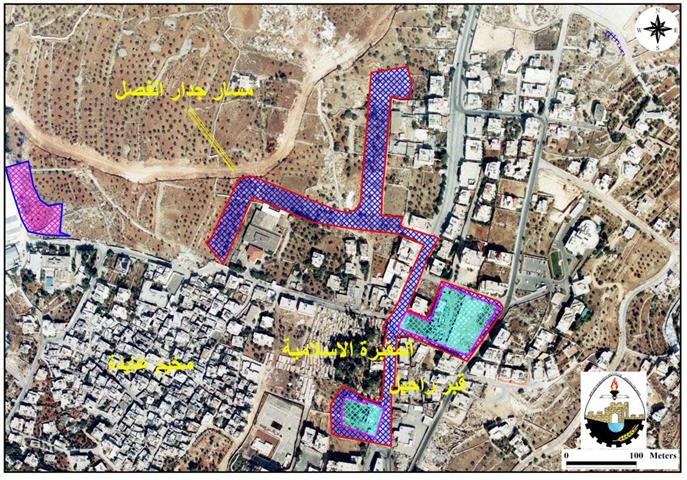The Israeli occupation army issued a military order on February 11th, 2005, carrying the number of ( T/17/05) and signed by the Israeli general commander Yaeer Nafeh. The order states the confiscation of Palestinian lands in Tel Rumaida area, in the western part of Hebron's Old City to build a new road for Israeli settlers that connects ' Ramat Yashai' settlement in Tel Rumaida with the three other settlements in the heart of Hebron city – ' Beit Hadasa, Beit Romano, Abraham Avino' .


( Photo 1 and 2- Copy of the military decree in Arabic and the attached map)
The road is planned to start from the middle of Al Shuhada street between ' Beit Rumano' and ' Abraham Avino' up to 'Ramat Yashai ' settlement in Tel Rumaida.

(Photo 3- Aerial photo of Hebron's old city shows the route of the planned road)
( Map 1- proposed road in Tel Rumaida and settlements)
Creating this road will lead to the demolition of historical houses, Muslims' graves, uprooting of long – lived olive trees and destroying ancient monuments in the area. Tel Rumaida area has been known as one of the famous archeological sites throughout centuries. It has been subjected to many Israeli settlers' attacks. See Photo 4 and Photo 5


( Photo 4 and Photo 5– Proposed route of road threatens graves, houses and olive trees- Photos courtesy of LRC)
Hebron Rehabilitation Committee has filed a complaint against the Israeli occupation authorities. Objections against the aforementioned order were also submitted by the affected Palestinian residents to the Israeli Military Objection Committee in Beit El in a procedure before setting up a court case against the Israeli high court.
The targeted land is owned by several Palestinian families, including the families of Abu Sakur, Abu Munshar, Igneiby, Al Saheb, Abu Ghalyoon, in addition to a Muslim cemetery, Al Saqawati Muslim shrine, and Al Ain Al Jadeda (water spring) which belong to the Islamic Waqf ( Islamic Trust) in Hebron.
For more details, the following table details information about the land targeted for confiscation by the aforementioned military order:
|
No. of Basin |
No. of Parcel |
Name of Owner |
|
34416 |
63 |
Khalil Isma'il Abu Sakur |
|
34416 |
64 |
Hasan Mahmud AlSaheb |
|
34416 |
65 |
Mahmud Khamis Al Saheb |
|
34416 |
93 |
Abdul Mu'ti Khalil Abu Munshar |
|
34416 |
96 |
Islamic Waqf ( Al Ain Al Jadeda) |
|
34416 |
104 |
Zaglul Salim Abu Ghalyoon |
|
34416 |
109 |
Waqf of Igneiby family |
|
34022 |
29 |
Islamic Waqf ( Islamic cemetery) |
|
34022 |
26 |
Heirs of Hasan Abu Awad Shahin |
Building the supposed road will reinforce the Israeli colonial presence in Hebron city and will increase the Israeli control over Palestinian areas, which, in effect, will create more tension in the city. Meanwhile, it will add more pressure on Palestinian residents, forcing them out of area.
( Photo 8- an orchard of long – lived olive tree threatened with uprooting by the road)
(Photo courtesy of LRC)
Implementing this decree violates Hebron Protocol which was signed between the Palestinian and the Israeli sides in January, 1997 as part of the peace agreements.
Historical background to Tel Rumaida
Hebron city was built originally around Tel Rumaida area. According to archeological excavations carried out by several missions, Tel Rumaida area is considered to be an archeological site that witnessed many civilizations throughout history. It is dated back to the Bronze period, the Iron period, the Roman period, Byzantine period and Islamic period.
Canaanites had built their political capital in Tel Rumaida more than 5500 years ago. Ein Al Jadeda in the east side of that area used to be the main water resource for Hebron. Hebronites had planted the fertile Hebron valley ' Wadi Al Khalil Al Khasib' in that area.
Many archeological excavations had taken place in Tel Rumaida area. The first one was during the period from 1963-1966 by the American mission under the supervision of archeologist Philip Hammond. Then, in 1982, 1985, 1986 and 1999 by Israeli archeological missions. All of the excavations and diggings have emphasized on the historical importance of Tel Rumaida and have approved the fact that the area had witnessed several civilizations.
Tel Rumaida area is considered an archeological site since 1944, when the British Mandate listed it within the historical sites of Palestine. Thereafter, the Jordanian government stressed that on it during its control of the West Bank until 1967.
Following the Israeli occupation of the West Bank in 1967, the Israeli government issued a military order considering the area as an 'archeological site' and prevented any constructions that might change its 'historical characteristics'. But, within its settlement strategy, Israel has allowed a group of settlers in 1984 to set several mobile homes (caravans) over that archeological site. Thereafter, the Israeli government has given blind eye to enlargement activities on the part of Israeli settlers, who, in 2000, succeeded to begin the construction of a new permanent and multi storey residential building on top of this historical archeological site.
The Land Research Center calls upon all local, regional and international bodies to stop the implementation of this dangerous military decree by intervening with the Israeli officials at all levels.
Prepared by
The Land Research Center
LRC


















